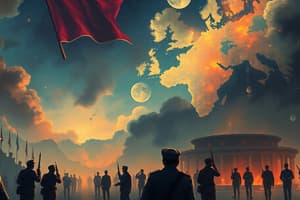Podcast
Questions and Answers
What were the two main opposing sides during the Cold War?
What were the two main opposing sides during the Cold War?
- North Atlantic Treaty Organization and Eastern Bloc
- Yalta and Potsdam Conferences
- Western Allies and Soviet Union (correct)
- United States and Western Europe
Which conference failed to address the fundamental ideological differences that led to the Cold War?
Which conference failed to address the fundamental ideological differences that led to the Cold War?
- Potsdam Conference (correct)
- Berlin Airlift
- Marshall Plan
- Yalta Conference
What was the purpose of the Truman Doctrine?
What was the purpose of the Truman Doctrine?
- To offer economic assistance to nations resisting communism (correct)
- To promote communist ideologies
- To form the Eastern Bloc
- To strengthen the Soviet Union
What was the significance of the Marshall Plan during the Cold War?
What was the significance of the Marshall Plan during the Cold War?
What event led to the launch of the Berlin Airlift during the Cold War?
What event led to the launch of the Berlin Airlift during the Cold War?
How did the construction of the Berlin Wall symbolize the Cold War tensions?
How did the construction of the Berlin Wall symbolize the Cold War tensions?
What event brought the world to the brink of nuclear war in 1962?
What event brought the world to the brink of nuclear war in 1962?
Which agreement required the Soviets to dismantle missiles in exchange for the US agreeing not to invade Cuba?
Which agreement required the Soviets to dismantle missiles in exchange for the US agreeing not to invade Cuba?
What marked the start of the Space Race between the US and the Soviet Union in 1957?
What marked the start of the Space Race between the US and the Soviet Union in 1957?
Which event symbolized the broader geopolitical competition during the Space Race era?
Which event symbolized the broader geopolitical competition during the Space Race era?
What characterized the period of détente between the superpowers in the late 1960s and 1970s?
What characterized the period of détente between the superpowers in the late 1960s and 1970s?
What ended the Cold War, resulting in the fall of the Berlin Wall in 1989 and dissolution of the Soviet Union in 1991?
What ended the Cold War, resulting in the fall of the Berlin Wall in 1989 and dissolution of the Soviet Union in 1991?
Flashcards are hidden until you start studying
Study Notes
History Class 12: The Cold War
The Cold War, which spanned nearly five decades, from the end of World War II to the early 1990s, profoundly shaped the geopolitical landscape and mindsets of the world. In this chapter of India's Class 12 history curriculum, we delve into the complexities of this period and its impact.
Origins and Key Players
The Cold War sprang from the ideological conflict between the Western Allies, led by the United States and its North Atlantic Treaty Organization (NATO), and the Soviet Union and its Eastern Bloc. The seeds were sown by the Yalta and Potsdam Conferences, which laid out plans for post-war Europe but failed to address the fundamental ideological differences between the superpowers.
Truman Doctrine and Marshall Plan
The United States, seeking to counter the Soviet Union's influence, initiated the Truman Doctrine in 1947, which offered economic and military aid to nations resisting communist aggression. The following year, the Marshall Plan provided Western European countries with $12 billion to rebuild their shattered economies, solidifying the US's role as a global leader.
Berlin Crisis and Berlin Wall
The Berlin Crisis in 1948, during which the Soviet Union blockaded West Berlin, prompted the US, UK, and France to launch the Berlin Airlift, delivering supplies to West Berlin and undermining Soviet power. The Wall's construction in 1961 divided Berlin and symbolized the Cold War's deepening tensions.
Cuban Missile Crisis
The Cuban Missile Crisis in 1962, when the US discovered Soviet missiles in Cuba, brought the world to the brink of nuclear war. Resolution was achieved through a diplomatic agreement that required the Soviets to dismantle the missiles, while the US agreed not to invade Cuba.
Space Race
The Space Race between the US and the Soviet Union started in 1957, with the launch of the Soviet satellite Sputnik, and culminated in the US's successful Apollo 11 moon landing in 1969. This era of intense scientific competition also symbolized the broader geopolitical competition between the two superpowers.
Détente and the End of the Cold War
The late 1960s and 1970s saw a period of détente (easing of tensions), characterized by increased cultural and economic exchange between the superpowers. The Cold War eventually ended with the fall of the Berlin Wall in 1989 and the dissolution of the Soviet Union in 1991.
Legacy and Implications
The Cold War's legacy includes its profound impact on global politics, military alliances, arms races, and the spread of nuclear weapons. The division of Germany and Europe also introduced new concepts like the Iron Curtain and the Bloc politics, while raising questions about sovereignty, human rights, and the role of superpowers in shaping world events.
The Cold War's end also ushered in a new era of globalization and interdependence. However, the residual effects of the Cold War continue to shape the world today, with ongoing debates about the role of superpowers and the balance between individual liberty and collective security.
As you study the Cold War, it's essential to appreciate the complexity of this era and to understand the nuances of the competing ideologies, geopolitical interests, and the broad range of factors that shaped events. The Cold War's legacy continues to resonate today, providing valuable lessons for students seeking to understand the world and their place in it.
Studying That Suits You
Use AI to generate personalized quizzes and flashcards to suit your learning preferences.




